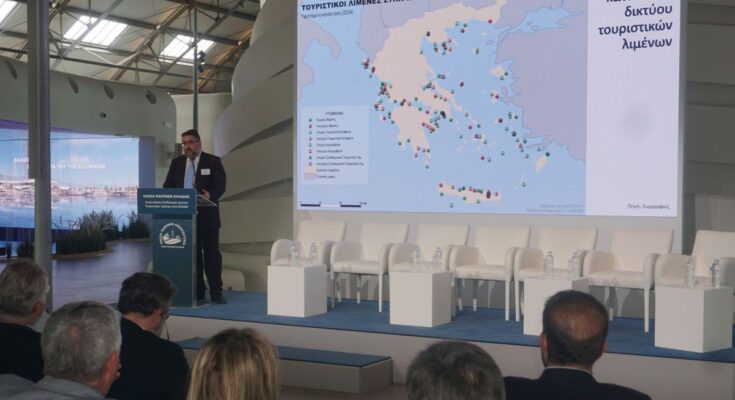
Dr. George Vaggelas, Associate Professor at Department of Ports Management and Shipping of the National and Kapodistrian University of Athens, presenting the “Spatial Planning of a Network of Tourist Ports in Greece” study.
The urgent need for faster licensing and the development of new marinas in Greece was underscored during the presentation of the study “Spatial Planning of a Network of Tourist Ports in Greece”, held Monday in Athens.
Commissioned by the Greek Marinas Association (GMA) with the consent of the Tourism Ministry, the study was prepared by university professors George Vaggelas and Thanos Pallis. It provides a roadmap for sustainable marina growth based on specific spatial and operational criteria.
GMA President Stavros Katsikadis noted that this is the first study to map development potential for tourist ports by region and municipality.

Greek Marinas Association (GMA) President Stavros Katsikadis
“It is an informative guide designed to highlight coastal areas with the highest potential for marina investment,” he said. “But without a modern institutional framework, progress will remain slow. Fast licensing, streamlined procedures, and central coordination are essential.”
Greece currently has 61 designated marinas with 18,652 berths, but only 39, with 12,336 berths, are operational. In comparison, Italy’s Riviera boasts 961 marinas with 181,000 berths, while Spain and Croatia have 130,900 and 66,000 berths, respectively. Turkey, Greece’s key regional competitor, has 80 marinas.

Dr. George Vaggelas, Associate Professor at Department of Ports Management and Shipping of the National and Kapodistrian University of Athens, presenting the “Spatial Planning of a Network of Tourist Ports in Greece” study.
The study estimates that by 2030, Greece could add 10 new marinas and 2,311 berths, raising its total to 14,827—still behind Croatia but ahead of Portugal. Additional capacity could come from hotel ports, tourist shelters, and anchorages, pending spatial planning approvals.
A key issue highlighted is the spatial fragmentation of marina infrastructure. “There are entire regions—Attica, the Ionian Islands, Western Greece—where berths exist outside the official tourist port map,” noted Professor Vangelas, stressing the need for a coordinated, criteria-based planning framework.
The upcoming Special Spatial Framework for Tourism is expected to address this. During the event, Secretary General for Spatial Planning, Efthimis Bakoyannis, confirmed that the assessment process will be completed by summer 2025, with finalization targeted by year’s end.
Competitive pressure is growing, according to Minister of Maritime Affairs and Insular Policy Vassilis Kikilias. “The rapid growth of yachting and cruising in Greece reveals the urgent need to strengthen marina infrastructure—not just for commercial vessels, but for maritime tourism as a whole,” he said.

Greek Minister of Maritime Affairs and Insular Policy Vassilis Kikilias.
However, bureaucratic barriers remain. Slow environmental approvals, delayed tenders, and legal challenges at the Council of State have hindered progress. “Without addressing these obstacles, projects cannot be delivered on time or yield meaningful results,” added the minister.
Kikilias and Tourism Minister Olga Kefalogianni both praised the study’s findings, noting that it offers valuable insight for policy decisions on marina development.
During her speech, Kefalogianni said that maritime tourism is a pillar of the national tourism policy. “Through the development of tourist ports, we aim to upgrade services, meet growing yachting demand, and enhance Greece’s competitiveness internationally,” she said.

Greek Tourism Minister Olga Kefalogianni.
She referred to the ministry’s flagship investment: a 139-million-euro marina upgrading program funded through the Recovery and Resilience Facility, currently underway. In addition, 28 investment projects have been approved across Greece, while maturity studies for designated marinas are being prepared.
Digital tools are also being introduced. A new platform for tourist ports—linked with the national registry of tourism businesses—will map infrastructure and offer promotion features powered by artificial intelligence.
Economic impact of maritime tourism

Greek Marinas Association (GMA) President Stavros Katsikadis.
According to GMA, the sector contributes more than 1.5 percent of GDP and supports 40,000 jobs. For every 100 berths, six direct and 100 indirect jobs are created. Tourist spending in marinas is five times higher than in hotel-based tourism, with VAT and public rent contributions exceeding 100 million euros annually.
Attica and the Cyclades are the leading regions in marina traffic, accounting for 40.7 and 13 percent of yacht movements, respectively, followed by the Dodecanese, Ionian Islands, and Crete.

Dr. George Vaggelas, Associate Professor at Department of Ports Management and Shipping of the National and Kapodistrian University of Athens, presenting the “Spatial Planning of a Network of Tourist Ports in Greece” study.
Looking across Europe, the disparity remains stark. Sweden has 2,000 marinas and 500,000 berths, France has 961 marinas with 181,000 berths, and the Netherlands counts 1,160 facilities. Turkey and Italy lead in average capacity, with 160 and 110 berths per marina, compared to Greece’s 40.
“The goal is not to pinpoint exact marina locations,” GMA President Katsikadis clarified. “It is to support municipalities with seafront potential and enable targeted, sustainable development. But we need legal clarity, institutional support, and investor confidence to make this a reality.”
Follow GTP Headlines on Google News to keep up to date with all the latest on tourism and travel in Greece.
Source link



